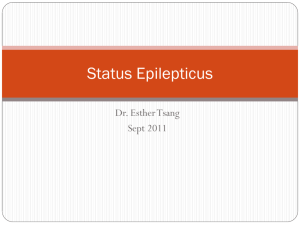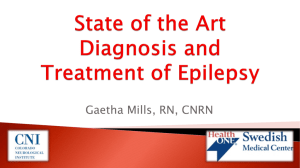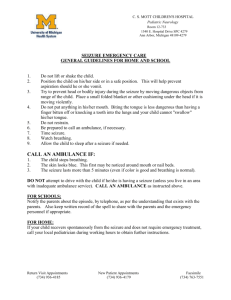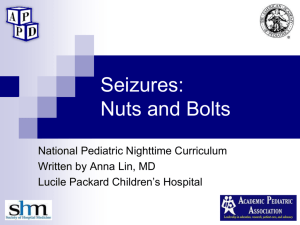Seizures - Clinical Departments - Medical University of South Carolina
advertisement
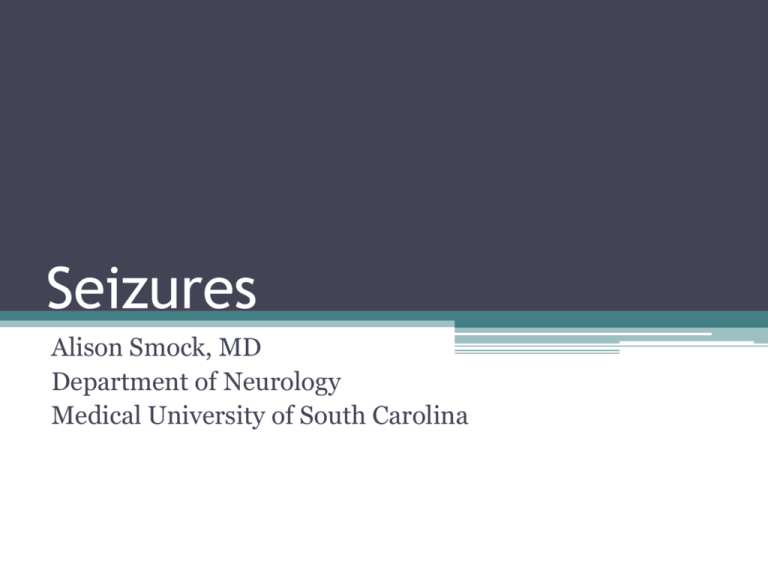
Seizures Alison Smock, MD Department of Neurology Medical University of South Carolina What is a seizure? • Paroxysmal, hypersynchronous, abnormal activity of neurons in the cerebral cortex • Seizures are symptoms of an underlying process • Manifestations of the seizure depend on the part of the brain affected The way that I like to think about it diagnostically and prognostically… Seizures • • • • • • • Provoked Unprovoked Medication non-compliance Metabolic derangements Drug use/EtOH withdrawal Infection Inflammatory state Structural cause Sleep deprivation • Epilepsy • Secondary epilepsy Types of seizures Mode of Onset Description Focal Without impairment of consciousness or awareness: With observable motor or autonomic components Involving subjective sensory or psychic phenomena only, corresponding to the concept of an aura With impairment of consciousness or awareness Evolving to a bilateral, convulsive seizure Generalized Tonic-clonic (in any combination) Myoclonic Myoclonic-atonic Myoclonic-tonic Non-convulsive Absence Typical absence Atypical absence With special features (ie eyelid myoclonia) Myoclonic absence Clonic Tonic Atonic Continuum (Minneap Minn) 2013;19(3):571-597. Semiology • Observable manifestations of a seizure • Stereotyped • Helps to classify the type of seizure/epilepsy a patient might have Semiology – simple motor seizure • Simple, unnatural, rhythmic movements that are due to stimulation of the primary and supplementary motor areas ▫ ▫ ▫ ▫ ▫ Myoclonic Tonic Clonic Tonic-clonic Versive simple motor seizure fasciculation Semiology – complex motor seizure • Complex motor movements that resemble natural movements but that occur in an inappropriate setting ▫ Automatisms • Complex partial seizures generally involve impaired awareness, so patients may appear to be doing purposeful things but are not responsive to external stimuli Semiology – generalized • Primary generalized seizure ▫ Tonic-clonic, tonic, clonic, myoclonic • Secondary generalization ▫ Starts as a focal seizure and rapidly spreads to involve both hemispheres Semiology – non-convulsive • Non-convulsive or “subclinical” seizures ▫ Highly varied spectrum of symptoms ▫ Mentation can range from alert, awake, and following commands to obtundation ▫ Periods of abnormal mentation that cannot be explained by metabolic/infectious abnormalities or structural lesions ▫ Patient’s with recent status epilepticus Standard work up for seizure • Take a good history ▫ ▫ ▫ ▫ Semiology Medications Substance abuse Risk factors: History of head trauma, stroke, brain tumor, intracerebral instrumentation Febrile seizures as a child History of meningitis/encephalitis Family history Birth history Semiology – taking a good history • If a patient’s chief complaint is “seizure” ask them: ▫ ▫ ▫ ▫ ▫ ▫ ▫ ▫ How does your seizure start What do you do during your seizure Do you lose awareness Is there extremity jerking/shaking Is there tongue biting Is there bowel or bladder incontinence How long does it last Are you fatigued afterward How long does it take for you to return to baseline Medications – taking a good history Agents reported to induce seizures Analgesics Fentanyl, mefenamic acid, meperidine, petazocine, propoxyphene, tramadol Antibiotics Pencillins, penems, cephalosporine, isoniazid, lindane, metronidazole, nalidixic acid, pyrimethamine Antidepressants Amitriptyline, bupropion, doxepin, maprotiline, mianserin, nomifensine, nortriptyline Antineoplastic agents Busulfan, carmustine, chlorambucil, cytosine arabinoside, methotrexate, vincristine Antipsychotics Chlorpromazine, haloperidol, perphenazine, prochlorperazine, thioridazine, trifluoperazine Bronchial agents Aminophylline, theophylline General anesthetics Enflurane, methohexital Local anesthetics Bupivacaine, lidocaine, procaine Sympathomimetics Ephedrine, phenylpropanolamine, terbutaline Others Anticholinergics, antihistamines, aqueous iodinated contrast agents, atenolol, baclofen, cyclosporine, domperidone, ergonovine, flumazenil, folic acid, foscarnet, hyperbaric oxygen, insulin, lithium, oxytocin, tacrolimus Substance abuse – taking a good history • • • • • • • EtOH Stimulants Anxiolytics Cocaine PCP Synthetic marijuana Analgesics Standard work up for seizure • Routine EEG • MRI brain with and without contrast • Basic lab work (and consideration of an underlying systemic cause) • If associated symptoms (autonomic) it would be prudent to get cardiology evaluation ▫ TTE ▫ Holter monitoring ▫ Orthostatic vital signs If you are unsure if the patient seized... • Objective measures of a generalized seizure (or multiple seizures) ▫ ▫ ▫ ▫ ▫ WBC Creatinine CO2 CK Prolactin? Status Epilepticus • 5 minutes or more of: ▫ Continuous clinical or electrographic seizure activity, or ▫ Recurrent seizure activity without recovery between seizures • Most clinical and electrographic seizures last <5’ and seizures that last longer often do not stop spontaneously • Animal data suggest that permanent neuronal injury and pharmacoresistance may occur before the traditional definition of 30’ of continuous seizure activity has passed Neurocrit Care. 2012 Aug;17(1):3-23 Continuum (Minneap Minn) 2013;19(3):571-597. Status Epilepticus • Convulsive status epilepticus Convulsions that are associated with rhythmic jerking of the extremities Clinical characteristics of GCSE: GTC movements Mental status impairment May have focal neurological deficits in the postictal period Focal motor status/EPC is not included in this definition Neurocrit Care. 2012 Aug;17(1):3-23 Non Convulsive Status Epilepticus • Seizure activity seen on EEG without clinical findings associated with GCSE • Two distinct phenotypes: ▫ The “wandering confused” patient presenting to the ED with a relatively good prognosis or chronic epileptic syndromes or, ▫ The acutely ill patient with severely impaired mental status, with or without subtle motor movements Frequently follows uncontrolled GCSE Neurocrit Care. 2012 Aug;17(1):3-23 Non Convulsive Status Epilepticus • Semiological spectrum of non-convulsive seizures is highly variable ▫ Negative symptoms: anorexia, aphasia/mutism, amnesia, catatonia, coma, confusion, lethargy, staring ▫ Positive symptoms include agitation/aggression, automatism, blinking, crying, delirium, delusions, echolalia, facial twitching, laughter, nausea/vomiting, nystagmus/eye deviation, perseveration, psychosis Neurocrit Care. 2012 Aug;17(1):3-23 What’s the prognosis? • GCSE ▫ Mortality At hospital discharge: 9-21% At 30 days: 19-27% At 90 days: 19% ▫ Morbidity Severe neurological or cognitive sequelae: 11-16% Deterioration in functional status: 23-26% At 90 days after SE, 39% will have marked functional impairment Neurocrit Care. 2012 Aug;17(1):3-23 What’s the prognosis? • NCSE ▫ Mortality At hospital discharge: 18-52% At 30 days: 65% Factors associated with poor outcome Underlying etiology, severe MS impairment, longer seizure duration For patients diagnosed within 30’ of seizure onset, mortality was 36% compared with 75% for those diagnosed >24 hours after onset Patients with NCSE treated and resolved within 10h had 10% mortality vs 85% mortality if seizures continued >20h Neurocrit Care. 2012 Aug;17(1):3-23 Acute treatment of SE • 1. ABCs • 2. Emergent initial therapy ▫ Benzodiazepines IV >IM/PR/Nasal Lorazepam IV Midazolam IM/nasal Diazepam PR Acute treatment of SE • Benzodiazepines ▫ Dosing: optimal ranges have not been defined Lorazepam 0.1mg/kg IV up to 4mg/dose May repeat dosing in 5-10 minutes Midazolam 0.2mg/kg IM up to 10mg (max) Diazepam 0.15mg/kg IV up to 10mg/dose May repeat dosing in 5 minutes ▫ Concern for respiratory depression and hypotension? N Engl J Med. 2001;345(9):631–7 Neurocrit Care. 2012 Aug;17(1):3-23 Acute treatment of SE • 3. Urgent Control Therapy ▫ Treatment with an AED following administration of short acting benzos is required in all patients who present with SE Exceptions? Neurocrit Care. 2012 Aug;17(1):3-23 Acute treatment of SE • Two potential goals of urgent control therapy ▫ For patients who respond to emergent initial therapy and have complete resolution of SE, the goal is rapid attainment of therapeutic levels of an AED and continued dosing for maintenance therapy ▫ For patient who fail emergent initial therapy, the goal of urgent control is to stop SE Neurocrit Care. 2012 Aug;17(1):3-23 Acute treatment of SE • Which AED to choose? ▫ VA Cooperative Trial in 1998 Many of the new AEDs were not available at the time of this trial ▫ Preferred top tier agents are: IV fosphenytoin/phenytoin IV valproate sodium (best choice for patients with PGE) IV phenobarbital IV levetiracetam Continuous midazolam infusion Neurocrit Care. 2012 Aug;17(1):3-23 http://www.bjs.co.uk/details/media/1043941/Purple-Glove-Syndromefollowing-intravenous-phenytoin.html Phenytoin • Check a free level ~8 hours after IV load ▫ PTN is protein bound ▫ Unbound PTN is active PTN ▫ Decreased protein binding contributes to higher levels of biologically active medication • Keep on continuous telemetry • Enzyme inducer – decreases AED levels of: ▫ ▫ ▫ ▫ ▫ ▫ ▫ VPA Lamotrigine Topiramate Oxcarbazepine Zonisamide Benzodiazepines Levetiracetam Valproate • Check a total level ~8 hours after IV load ▫ VPA is protein bound ▫ Unbound VPA is active VPA ▫ We don’t have the ability to measure free VPA at MUSC • Monitor platelets • Can be given as a gtt for refractory seizures • Enzyme inhibitor –increases AED levels of: ▫ ▫ ▫ ▫ Lamotrigine Carbamazepine Phenobarbital Ethosuximide Levetiracetam • • • • • • Bioavailability is 100% Oral absorption is rapid and almost complete Renally excreted Little to no drug-drug interactions Behavioral symptoms (5-13% of adults) Can cause leukopenia and neutropenia When should you check AED levels? • If you are trying to achieve a therapeutic level after SE • If the patient displays symptoms consistent with toxicity • If there are no other reasons that you can find for a patient to have breakthrough seizures (and is supposed to be taking an AED) AED levels at MUSC • < 24 hours ▫ ▫ ▫ ▫ Phenytoin Valproate Carbamazepine Phenobarbital • 2-4 days (send out) ▫ ▫ ▫ ▫ ▫ ▫ Levetiracetam Oxcarbazepine Zonisamide Lamotrigine Lacosamide Topiramate EtOH withdrawal seizures • GABA – major inhibitory neurotransmitter in the brain ▫ Highly specific binding sites for ethanol are found on the GABA receptor complex ▫ Chronic ethanol use induces insensitivity to GABA such that more inhibitor is required to maintain a constant inhibitory tone ▫ As alcohol tolerance develops, the individual retains arousal at concentrations which would normally produce lethargy or coma EtOH withdrawal seizures • Generalized tonic-clonic • Usually occur within 12-48 hours after the last drink, but may occur more quickly after abstinence • Predominantly occur in patients with long history of chronic alcoholism • Usually singular or occur as a brief flurry over a short period • Recurrent or prolonged seizures or SE should prompt an investigation into other etiologies EtOH withdrawal seizures • Treatment is typically benzodiazepines • Several studies have demonstrated that phenytoin is ineffective in this clinical context • If a patient has epilepsy but is also an alcoholic, leave their AEDs as they are and proceed with AWS protocol • Gabapentin taper is a great tool ▫ 400mg TID x 3d 400mg BID x 3d 400mg Qday x 3d off Alcohol Clin Exp Res. 2009 September; 33(9): 1582–1588. Non-epileptic events • • • • • • Convulsive syncope Cardiac arrhythmias Parasomnias Movement disorders Conversion disorder Malingering Convulsive syncope • Paroxysmal event of loss of consciousness and postural tone caused by cerebral hypoperfusion with spontaneous recovery • Patients are generally orthostatic by vital signs or their history Psychogenic NEEs • Hints that this might be a non-epileptic event: ▫ ▫ ▫ ▫ ▫ ▫ ▫ ▫ ▫ ▫ Eyes are closed Head crosses midline Asynchronous movements of extremities Events are only ever witnessed Multiple types of spells Duration of event Rapid return to baseline Do not occur during sleep Lack of autonomic symptoms No response to AEDs Psychogenic NEEs • Diagnosis ▫ EEG ▫ Psychiatric history ▫ Referral for psychiatric evaluation





